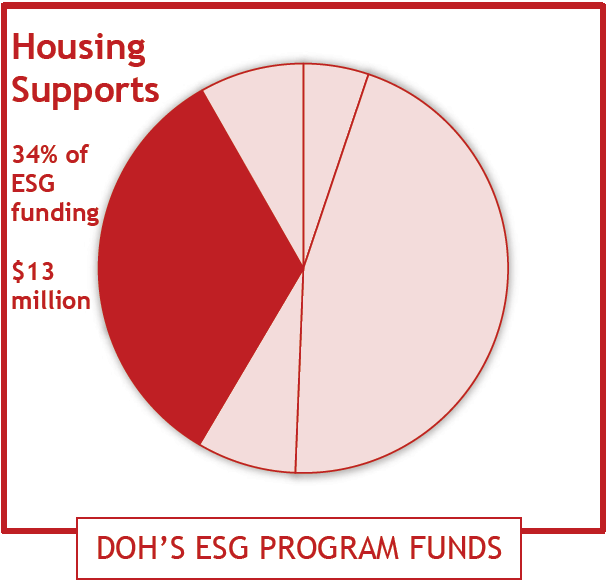Leading with Lived Expertise: Housing Supports
Overview of Housing Supports 
ESG can pay for permanent housing solutions through two program components: homelessness prevention (HP) and rapid re-housing (RRH). Both components allow for rental assistance and payment of rental arrears, as well as the financial and service support needed to maintain or regain housing. These two components play an integral role in the ESG program as the only components that can pay for permanent housing solutions. They should be paired with street outreach and emergency shelter programs as often as possible.
Historically, DOH’s ESG HP and RRH programs flowed through Continuums of Care (CoC) in order to ensure collaboration with those entities: DOH awarded funds to CoCs and CoCs awarded the funds to providers. Providing HP and RRH funds to the CoCs, rather than directly to all providers also helped meet program requirements such as using the Homeless Management Information (HMIS) and participating in Coordinated Entry Systems. With the significant increase in funding over the last five years, however, DOH and its CoC partners determined it is most efficient to have these permanent housing funds go directly from DOH to providers. It also gives providers the resources to truly create housing-focused homelessness response programs.
 ESG Currently Supports Housing & Tenancy Support by Paying for:
ESG Currently Supports Housing & Tenancy Support by Paying for:
- Expenses that are necessary to help participants regain housing stability in their current housing or move into other permanent housing with housing and tenancy supports.
- Rental assistance including arrears.
- Financial assistance including rental application fees, security and utility deposits, utility payments, last month’s rent, and moving costs.
- Services costs including housing search, housing stability case management, landlord-tenant mediation, tenant legal services, or credit repair.
Recommendations for DOH’S ESG Housing & Tenancy Support
Transitioning into housing can be confusing, overwhelming, and triggering for many people, especially for those who have experienced homelessness for years or decades. DOH’s ESG programs must build support for the transition from homelessness to housing as well as throughout the adjustment period once housed. Specifically, programs should create policies that make the process transparent and safe for those who might not trust the homeless response system. Providers are in a unique position not only to support people through this transition and in housing but also to address the main challenge of finding permanent options - the lack of enough affordable housing units in Colorado. DOH’s ESG programs must build the capacity to provide landlord outreach and mediation, walk hand-in-hand with participants through confusing application processes and lease language, and implement other best practices that put finding, obtaining, and maintaining permanent housing at the center of all agency actions.
The “3 E’s” for Creating Equity in Housing & Tenancy Support
Empower
- Housing programs are a great opportunity for people with lived experience to explore a career in the homeless response system. Create peer support programs in housing programs.
- Housing programs often provide resources that are dense and overwhelming. People with lived expertise should design housing navigation strategies to make sure that those currently looking for housing can utilize available services effectively.
- Housing programs spend significant time providing housing and tenancy supports once participants are housed, but some participants will return to homelessness anyway. People with lived experience can help identify what parts of re-housing can be overwhelming and can help create plans if that happens. Should your housing project have space where people can sleep outside until they are ready to sleep in their unit? Should programs work to identify and prevent triggers that housing units might have based on location, design, etc.?
- Housing programs can offer competitive advantages to landlords by providing an additional level of support for tenants at no cost to them. Those with lived experience can speak to how this support will avoid issues firsthand.
- Peers working to support housing can identify potentially dangerous/damaging behavior before it becomes an issue that interferes with housing options.
Engage
- In order to obtain housing units in tight markets statewide, ESG programs must engage with private landlords and work to fill gaps that currently keep landlords from being willing to rent to those with checkered rental histories. Programs must gather input from landlords and proactively build housing programs that address local challenges and barriers.
- Landlord outreach and mediation requires collaboration across agencies in order to work effectively. Each ESG program should not maintain its “own” list of landlords but must instead share landlord partners with CoC partners so that agencies do not waste valuable time and resources recruiting the same units or providing duplicate incentives.
- Collectively, programs can make a strong financial arguments to landlords looking to fill units. Programs should collaborate with one another to use that collective power strategically.
- Once housed, people may need a variety of support. Housing providers, like shelter providers, should not try to be everything to each person but instead must leverage existing community resources to meet needs and only fill gaps if they exist.
Evaluate
- Are different groups getting housing at different rates? Why? Are there systematic inequities that our housing programs inadvertently perpetuate, and how are we creating feedback loops to see this data in real time?
- How quickly can programs get participants into housing? If it takes a long time, what are the barriers according to the data? The answer cannot just be that there are not enough units. What are agencies doing to meaningfully increase access to available units and how are they measuring this focus so that they can target limited resources on the solutions that work?
- How long are people staying housed? Programs should implement methodologically sound follow-up strategies that provide representative samples for this follow-up at a year or more after program exit to ensure housing stability. This follow-up cannot just rely on completing individual follow-up surveys but must instead leverage system data to ensure that no confounding variables are skewing positive outcomes to be artificially inflated.
- Programs should regularly survey landlords that are renting units to program participants to identify what challenges exist before creating landlord incentives. This will ensure that limited resources are addressing felt needs, as opposed to providing incentives that might not increase landlord involvement or the likelihood of renting to program participants.
More Impressions from the LEAG
Housing (with supports) is the answer to homelessness. That can be a hard transition for people and should be addressed intentionally and strategically.
“Get ready for a difficult transition. Getting housing is good news, but it's not an end to all of your troubles. It's the end of a lot of them, but also the beginning of some new ones (or the restarting of some old ones you may have forgotten about).”
The housing needs of individuals experiencing homelessness are as diverse as those individuals are: each person needs different supports in order to be successful in housing long-term. Housing programs face another huge challenge in the lack of affordable housing units across Colorado. This creates long wait times for housing, incredibly competitive rental markets, and significant challenges for anyone with less than perfect rental histories. Many programs feel the need to protect their relationship with the few landlords who are willing to work with them. Therefore, DOH’s ESG programs must have the capacity to address both the needs of program participants and the needs of landlord partners consistently and effectively.
Since the goal of housing programs is to address housing needs, they will inherently depend on the local private housing market. Colorado’s market does not meet the need, so programs must collaborate to reduce wait times for participants and increase effectiveness of working with limited available resources. Fundamentally, ESG can help housing access and placements increase.
Next Steps for DOH’S ESG Program: Housing & Tenancy Support
In response to this input, DOH staff will:
- Create specific metrics to ensure that ESG-funded housing programs 1) prioritize the inclusion of lived experience in program development, 2) focus on permanent housing with tailored supports as quickly as possible, 3) measure returns to homelessness to evaluate the effectiveness of services offered, and 4) incorporate landlord outreach efforts that can be utilized to increase access to limited affordable housing units available.
- Provide technical assistance programs for housing providers that is developed and reviewed by the LEAG members to ensure they meet housing needs. These tools will focus on creating tailored housing navigation and support programs that meet people’s unique needs as well as effective system-wide landlord outreach efforts.
- Implement monitoring tools that ensure all ESG-funded programs are focused on helping households secure permanent housing as quickly as possible, maintain that housing as long as possible, and utilize effective landlord outreach strategies to accomplish housing placement goals.
“The long wait for housing is often such a deterrent. Even if someone is given a voucher, finding housing is difficult and the list is long.”
